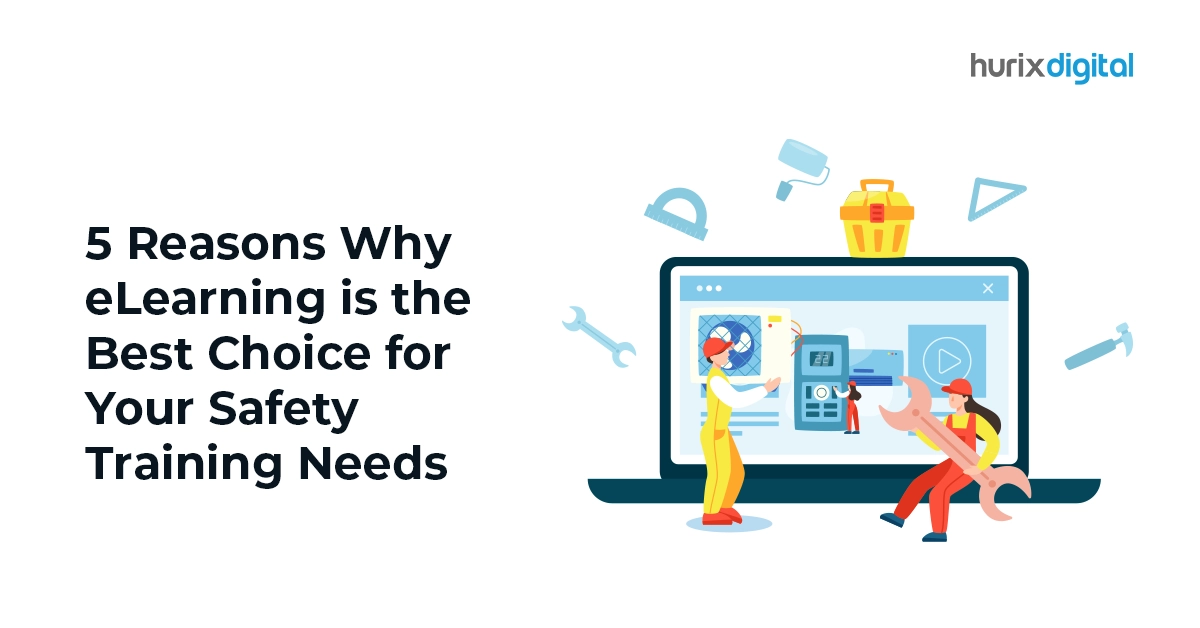
5 Reasons Why eLearning is the Best Choice for Your Safety Training Needs
Summary
Discover why eLearning is an effective solution for safety training. This article highlights five reasons eLearning is ideal for delivering comprehensive and engaging safety training.
In the last few years, eLearning has emerged as a convenient and flexible mode to boost reach and learning effectiveness at various education levels. The cost-effectiveness of the eLearning model, as compared to traditional training methods, also makes it an attractive option.
By 2026, the global eLearning industry is estimated to grow to a market size of $ 400 billion, which is double the size of the industry in 2019.
The flexibility, innovativeness, and accessibility of eLearning have also made it the go-to mode for innovative and transformative safety training at workplaces, an essential pillar of success for business growth.
We deconstruct the role of safety training in building sustainable work cultures and the advantages delivered by eLearning in this context.
Table of Contents:
What is Safety Training?
The safety and well-being of employees in the world of work play an important role in building sustainable businesses. Safety protocols can vary based on the nature of the business, the sector, and other factors. Here are some examples of safety requirements:
- Factory workers need to follow all safety protocols when operating heavy machinery.
- Executives need training on how to operate emails and other online software without compromising data security.
- Employees need training on the guidelines that protect workers against harassment in the workplace.
- Healthcare professionals must maintain their own safety as well as that of patients.
- A growing number of companies are also concerned about aspects such as employees’ physical and mental health, which contribute to workforce productivity.
- Those working in the financial sector will need compliance training to ensure that ever-evolving regulatory guidelines are followed.
Today, safety training programs are emerging as an important aspect of employee development. Hence, businesses need to build an effective framework to administer such programs on an ongoing basis. More importantly, the courses need to be engaging, accessible and cost-effective. eLearning offers opportunities to achieve all these goals and build robust programs.
Also Read: Top 5 Tips on Reducing Turnover Rates with Complete Staffing Solutions!
How Does Online Training Boost Safety Training: Top 5 Ways
A snapshot of multiple ways in which eLearning helps execute effective, sustainable, and scalable safety training.
1. Boosts Engagement through Interactive Learning Experiences
Professionals and workers typically invest time and effort in building domain knowledge and skills. However, they often tend to overlook or skim through hygiene factors such as safety training. Thus, they need to be made more appealing to workers.
The traditional training methods of physical lectures are cumbersome to organize and lack an engaging appeal.
However, the adoption of eLearning creates scope to learn via multimedia elements such as video-based training modules, 3D models, eBooks, podcasts, audio representations, slides, and infographics. The use of these interactive elements helps in the retention of concepts and creates more engaging experiences, which score over classroom-style lectures.
There’s also a growing adoption of Artificial Intelligence (AI) to build tools such as chatbots, which have the capacity to engage with learners 24/7.
2. Nudges Workers Towards Self-Learning
Professionals today seek flexibility and convenience. The flexibility of eLearning is an attractive aspect when it comes to safety training.
- Designing certification courses that offer on-demand resources, empowers professionals to learn as per their schedules.
- Secondly, the design of bite-sized learning resources encourages micro-learning, a practice where learners can absorb information in a few minutes.
- Another popular trend is that more learners are doing so via mobile.
These trends make it convenient for professionals to dedicate 10 to 15 minutes, or more in a day, to learning, thus making the learning experience an ongoing process.
eLearning supports learners who practice micro-learning, learn via mobile, and engage in flexible learning as per their timelines. The availability of on-demand training paves the way for learners to be less dependent on facilitators.
3. Enables Easy Creation of Personalized Learning Paths
Today, there’s a growing shift towards personalizing learning paths. This approach allows workplaces and education providers to bridge the gaps for individual learners.
For instance, if a learner is struggling with specific challenges, these can be addressed through coaching sessions and the recommendation of specific resources. Accurate assessment of safety, healthcare, and compliance knowledge is also an important aspect of the learning process.
The use of technologies such as robotic automation, AI, and machine learning is enabling the automation of the entire personalization process, from the creation of resources to assessments. Furthermore, the assessment approach comes with innovation in terms of assessment formats. Additional layers, such as gamification, serve as a motivator in the learning process.
4. Create Simulated Practical Experiences
Practical experience is an important aspect of safety training. Offline training requires a significant investment of resources and effort. On the other hand, the use of technologies such as Virtual Reality (VR) and Augmented Reality (AR) allows businesses to curate live simulated experiences that supplement knowledge training.
The use of AR and VR allows professionals to build hands-on skills in different scenarios. However, the cost of training is significantly reduced. New scenarios can be replicated easily, and multiple team members can participate in a simulated experience. Thus, professionals can build collaborative and independent skills.
5. Build Agile, Data-driven Training Programs
With market scenarios continuously evolving, safety training programs must be designed as an agile experience. For instance, trainers must be able to update content, multimedia, and assessment quickly, seamlessly, and at scale.
The use of a superior, automated, data-driven Learning Management System gives trainers more power, as they can now update resources quickly and at scale.
New learners can be onboarded easily, and their progress can be tracked through in-built data analytics. Thus, fresh content can be designed based on data rather than intuition. These tools are a game-changer, enabling businesses to strengthen their safety training efforts and make them highly effective.
Also Read: A New Approach for the Emerging Hybrid Workforce
Takeaway
Shifting from traditional training modes to eLearning is an inevitable step in a digitized world. Today’s workers have access to smart devices and the Internet, making it easy to nudge them towards online employee training.
Businesses can conduct their safety training and other employee development programs on a large scale and in a sustainable way. Simultaneously, they can also bring down costs and drive a higher ROI.
If your business is looking to transform its training approach, Hurix Digital has the expertise to support your training needs. Reach out to us to start a conversation and leverage top-notch online safety training models for your business.

A highly enthusiastic and motivated sales professional with over twenty five years of experience in solution selling of training-related applications and services. Maintains an assertive and dynamic style that generates results. Ability to establish long-term relationships with clients built on trust, quality of service and strategic vision. Specializes in financial services, higher ed, publishing and government in the areas of learning and development.








